|
Newsletter on line. This newsletter, and previous editions, are available on the RUSI Vancouver website at: http://www.rusivancouver.ca/newsletter.html Wednesday Lunches The 15 Field Officers Mess holds weekly lunches, serving a 5 course, ‘homemade’ meal for only $15- you won’t find a better meal - or a better deal, anywhere. If you are in the area on a Wednesday, drop in and join us for lunch. St Barbara’s Day Special Guest Night The deadline for RSVPs for this event is fast approaching. If you plan to attend, please let us know ASAP. See invitation at end of this newsletter. Commanding Officers Christmas Tea – December 13 The annual CO’s Christmas Tea will be held on Sunday December 13, 2015. This is probably the most enjoyed event of the year. The cost, $20pp, includes sherry, Mrs Lum’s delicious hors d'oeuvres, as well as coffee and tea served by Regimental Ladies. The Regimental Band is sending one of its combos to entertain us as we mingle. The bar will be open for those of you who want more than sherry. Dress is suit and tie (or Regimental blazer and tie) for gentlemen and the equivalent for ladies. See invitation at the end of the newsletter. New Year’s Levée – 1 Jan 2016 15 Fd Artillery Regiment is holding their annual Levée. The Messes will open for visitors at 1100hrs. A light lunch will be served starting around noon. World War 2 - 1940 John Thompson Strategic analyst quotes from his book “Spirit Over Steel” Nov 18th: A Sunderland Flying Boat detects a U-Boat with its new airborne radar – a first in ASW history. Nov 19th: Greek counterattacks drive the Italians back over the Kalamas River. Nov 20th: Hungary agrees to an alliance with Germany and Italy. Nov 21st: The Greek counter-offensive takes another 2000 prisoners and much heavy equipment, the Italians start withdrawing back into Albania. The Dies Report on Nazi and Communist espionage and subversion is published in the US, it does overestimate the situation. Nov 23rd: Lord Lothian arrives in New York as the new British ambassador to the US; his first priority is raising some capital for Britain is going broke. Romania becomes an Axis Ally. Nov 24th: Slovakia – already a puppet state – becomes a party to the Axis Tripartite Pact. 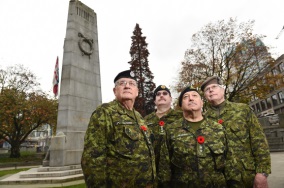 Remembrance Day Events across Vancouver Article by Sandra Thomas Vancouver Courier Honorary Colonels Ted Hawthorne, Bill Diamond and Michael Shields and Honorary Lieutenant Colonel Allan De Genova will wear their working uniforms for the entirety of Veteran’s Week as part of a Canada-wide initiative. Photo Dan Toulgoet. Due to several acts of aggression towards military personnel in Canada last year, some members had been warned to limit wearing their uniforms to official duties. That’s something Honorary Lieutenant Colonel Allan De Genova of 15thField Regiment wants to change. “I’m of the feeling we don’t need to hide, but we should stand with honour,” said De Genova. “I’m proud to represent all of the men and women who give of themselves every day. It’s our duty to be able to recognize that.” To that end, De Genova wants all honorary officers across Canada to wear their camouflage work uniform for the entirety of Veteran’s Week, Nov. 5 to 11. De Genova, a realtor by trade, plans to wear his uniform to all military events, on personal errands and to meetings. “People will not only see the poppy, but also the uniform,” said De Genova. “And when someone stops me to ask about it or thank me, I’ll tell them, I’m an honorary, but I’m very happy to convey that message to the men and women who serve every day.” ______________________________________________________________________________________________________ The Honoraries, along with Hon Col Bill Rodgers (not in this picture), Hon Col of 15th Field, laid wreaths for their respective Units on Remembrance Day. At the Cenotaph in Victory Square in Vancouver two trumpeters from VFRS sounded Last Post and Rouse in tandem. This is Battalion Chief Dan McClelland on top of the Flack Building opposite the Cenotaph. Above, four Harvard aircraft perform a fly past. The other trumpeter, Assistant Chief Joe Foster (also a member of 15Fd Band), was located at ground level near the podium. Down at Portside Park, the 15 Field Artillery Regt fired a 21 Gun Salute in honour of our fallen comrades. A good contingent of Cadets from 15 Fd Cadet Corps and 111 Squadron RC Air Cadets paraded, along with members of the Regt, the Saluting troop and many Gunner retirees and family members. 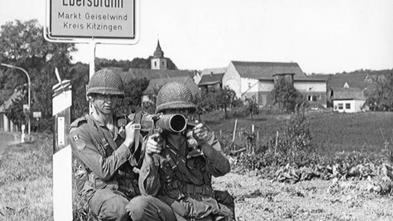 Canada’s Forgotten Cold Warriors Paul Manson Contributed to the Globe and Mail Nov. 11, 2015 The federal election campaign, coupled with recent compelling reporting in The Globe and Mail about Canada’s military veterans, has stimulated welcome – and much needed – discussion about our veterans and the ways in which they are treated. But references in two recent and otherwise thoughtful articles follow a disturbing pattern. One article, which included tallies from Veterans Affairs Canada, referred to “685,300 Canadian veterans: 75,900 from the Second World War, 9,100 from the Korean War and 600,300 from subsequent peacekeeping missions and conflicts, including at least 40,000 younger Afghanistan war vets.” Another opinion article took up the same theme, referring to Canadian casualties in the First and Second World Wars, Korea, Afghanistan and “numerous United Nations peacekeeping assignments.” Canadian soldiers take part in a NATO exercise in West Germany in 1989. (Sgt. Margaret Reid/Canadian Forces/The Canadian Press) Stunningly absent from both accounts is even the slightest mention of what was by far Canada’s most important military activity since 1945: Our contribution to NATO and NORAD in the Cold War, from 1950 to 1990. It was a massive commitment. Several hundred thousand Canadian military members served in the vital cause of deterring Soviet aggression, thereby joining Canada’s allies in preventing the outbreak of a third world war and the nuclear holocaust that would have ensued. And our Canadian soldiers, sailors and air officers were good. At one point, the Supreme Allied Commander in Europe, an American, told me, “You Canadians set the standard in NATO.” We were well trained, well equipped and superbly motivated. In spite of unique organizational challenges, we earned great respect from our allies. Our small but powerful mechanized brigade in West Germany was an elite force, given the toughest assignments. Our air force, both in NORAD and in Europe, won numerous competitions, especially with the Canadian-built and powered F-86 Sabre, considered the world’s best fighter in the 1950s. At sea, our navy showed that it was a quality force. On several occasions, a Canadian was chosen to command NATO’s Standing Naval Force Atlantic. Canada and Canadians paid a heavy price for all this. To put it concisely, our Cold War operations resulted in more fatalities due to military service than in the Korean War, the Balkan conflicts, the Gulf Wars, Afghanistan and peacekeeping – combined. For aircrew deaths alone, the number was 926. Why has this been forgotten, to the extent that Cold War veterans apparently don’t seem to deserve even a passing mention these days? Some possible reasons come to mind. Much of this happened a relatively long time ago, much of it far from home – in the north, at sea, in Europe. And news media coverage was much less intensive in the days before real-time TV reporting and embedded journalists. For example, whenever a Canadian airman was killed in Europe (as more than 100 were), he was invariably buried in a small military cemetery in Choloy-Ménillot, France; no ramp ceremony, no funerary procession along the Highway of Heroes, no headlines. Then there is the mythology that has arisen to the effect that peacekeeping has been the principal occupation of Canada’s military since the Second World War. Our Blue Beret peacekeepers did wonderful work back when there were real opportunities for keeping conflicting armies apart, but the reason they were so effective is that they had the skills and credibility that come from having been trained for modern heavy warfare. Another explanation for the public silence regarding Canada’s NATO and NORAD veterans is that there has emerged a troubling tendency on the part of some in this country to look upon those who did not fight in a shooting war as second-class veterans. My entire career was encompassed by the Cold War years, including 10 years with my family in France and Germany. The Cold War, however, was not a shooting war. I have told Canadians on many occasions that my greatest pride in having served is that, from the end of the Korean War until I retired 37 years later, not a single shot was fired in combat by the Canadian military. Our job was deterrence, and deterrence worked. We trained for war so that we wouldn’t have to fight a war. It’s a shame that the story has been largely forgotten. On this Remembrance Day, my earnest hope is that Canadians, when they pause to commemorate the many sacrifices that our veterans have made through the years, will give a moment to those whose service as Cold Warriors, although unheralded, really made a difference. Lest we forget.  "One Veteran, One Standard" Veterans Minister Kent Hehr’s Mandate Letter David Pugliese, Ottawa Citizen Nov 13, 2015 Defence Watch is running the main portions of the ministerial mandate letters relating to defence and veterans in three separate postings. Here are the relevant portions for Kent Hehr, Veterans Affairs Minister. The letter was sent by Prime Minister Justin Trudeau: Veterans and their families have earned our respect and gratitude. Veterans should not have to fight their own government for the support and compensation they have earned. As Minister of Veterans Affairs and Associate Minister of National Defence, your overarching goal will be to ensure that our government lives up to our sacred obligation to veterans and their families. I expect you to ensure that veterans receive the respect, support, care, and economic opportunities they deserve. You will ensure that we honour the service of our veterans and provide new career opportunities, make it easier for veterans to access services – including mental health services – and do more to support the families of Canada’s veterans. I ask you to work closely with your colleague the Minister of National Defence to ensure a seamless transition for Canadian Forces members to the programs and services of your department. In particular, I will expect you to work with your colleagues and through established legislative, regulatory, and Cabinet processes, including our first Budget, to deliver on your top priorities:
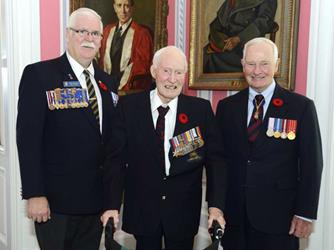 Lt Col John MacIsaac (1920-2015) Horrors of D-Day made vet appreciate Canada's 'golden age' Blair Crawford, Ottawa Citizen November 6, 2015 On the morning of the day he died, Lt.-Col. John MacIsaac donned his blue blazer, affixed a row of a dozen medals to his chest above his brass Royal Canadian Artillery badge, and headed out with other veterans to Rideau Hall for the launch of the 2015 Poppy Campaign. MacIsaac got his poppy, sweet-talked his way into getting a short tour of Rideau Hall, then headed home to the Perley and Rideau Veterans’ Health Centre. That night at dinner, he collapsed of a massive heart attack. The Juno Beach veteran died on Oct. 22, exactly one week after his 95th birthday. “May we all be so lucky,” said his son, Shaun MacIsaac. “It’s nice to have smiled and enjoyed your last day.” Lt Col John MacIsaac, centre, photographed with Gov. Gen. David Johnston and Royal Canadian Legion Dominion President Tom Eagles on Oct 22 at the launch of the 2015 poppy campaign at Rideau Hall. MacIsaac, a D-Day veteran who turned 95 the week before, died later that day. Sgt Ronald Duchesne / Rideau Hall But there was another day the elder MacIsaac might have preferred to forget. At dawn on June 6, 1944, then-Lt. John MacIsaac was steaming full speed toward the French coast aboard a landing craft tank. The Nova Scotia native was a gunnery placement officer on a Priest — a tracked, armoured vehicle nicknamed for its high, pulpit-like machine-gun mount. For the next hour after the first Canadian troops landed on Juno Beach, MacIsaac and his unit bobbed offshore in their landing craft, lobbing 105-mm shells over the heads of the Canadians and onto the German defences. MacIsaac’s craft finally made its run ashore at 9:25 a.m., about 90 minutes after the first assault. Normally, he would have been in charge of placing the guns in their firing position, but on D-Day he was pushed into duty as a forward observation officer, on the front line with the troops, calling back targets to the guns. It likely saved his life, said Shaun MacIsaac. His Priest was hit, killing the entire crew. “If he’d been with it, he would have been one of them. He sort of cheated death at the landing by taking the more-dangerous job of going ahead of it.” 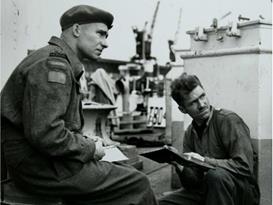 Lt. John MacIsaac, left, and Bdr Charles Zerowel, 14th Field Regiment, Royal Canadian Artillery, England, June 4, 1944 Library And Archives Canada / The Ottawa Citizen John MacIsaac recalled the landing in a 2004 interview with the Citizen commemorating the 60th anniversary of D-Day. “I saw people being wounded, taken off the beach,” he told the Citizen. “I saw a lot of dead soldiers lying around. I saw landing craft immobilized … like sitting ducks.” Too busy to be frightened, MacIsaac and his battery of Priests eventually rolled off the beach and into the bitter fighting around the town of Bernières-sur-Mer. “You intentionally didn’t think too much about what was going on around you,” he told the Citizen. The war, of course, wasn’t over after D-Day. MacIsaac’s unit fought through Normandy and the ferocious Falaise Pocket, then across France, Belgium and the Netherlands and right into Germany itself. He told Shaun of how the troops shared their meagre supplies with Dutch families who had been starved during the Nazi occupation. In November 2014, the French government made him a Chevalier de la Legion d’honneur for his wartime service to liberate France. “The war had an impact of making him quieter than he should have been,” Shaun said. “He was just so happy to be alive, to have made it through it.” 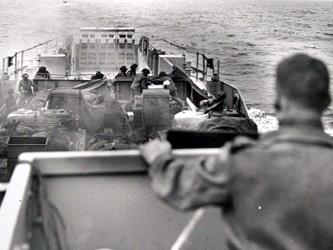 Lt John MacIsaac, foreground, watches as his landing craft tank heads toward France for the D-Day invasion at Juno Beach. Library and Archives Canada / The Ottawa Citizen John Francis Donald MacIsaac was born Oct. 15, 1920, in Inverness, N.S. He was just three when his father was killed in a coal-mining accident. His mother moved John and his younger brother, Hugh, to Halifax, where MacIsaac would eventually study at St. Mary’s University. He enlisted in the army as soon as the war broke out. “Until about age 70 he didn’t want to talk about it. He considered war a horror,” Shaun MacIsaac said. “He had respect for his opponents. He realized that a lot of young, brave Germans were dying along with a lot of young, brave Canadians, British and Americans. But he also had a sense of the need to defeat the enemy, which was truly evil, and that the cause was noble.” MacIsaac returned to Halifax when the war ended, studying law at Dalhousie University. He later rejoined the army, serving with the Judge Advocate General branch, including service in Korea in 1952-53. MacIsaac retired from the army in 1969 and took a position as legal adviser to the Atomic Energy Control Board, the federal watchdog of nuclear safety, where he assisted in drafting the laws and regulations governing Canada’s nuclear industry. He married his wife, Mary, in 1950 and the couple had five children — Jane, Anne, Shaun, Hugh and Michael — and 13 grandchildren. MacIsaac returned to Normandy in June 1984 for the 40th anniversary of D-Day and again in 2004 for the 60th, this time with the entire family in tow. MacIsaac continued to serve after his retirement, volunteering with his parish, Our Lady of Mount Carmel on St. Laurent Boulevard, and at the Shepherds of Good Hope, where he sorted and packed groceries. “He had to be contributing,” Shaun said. “He’d rather be being useful than sitting around.” Always athletic — he had considered a pro baseball career as a young man — MacIsaac took daily walks and was an enthusiastic swimmer at MacKay Pond, usually the first person in the spring and the last one out in the fall. Having survived combat, he couldn’t understand negativity in people, Shaun said. “He just seemed so pleased with life and this wonderful Canada we built post-World war Two. They’d seen the horrors over there and then to come back to this truly golden age.”  Who is it? Last Week: We believe the photo was taken in the early 2000’s at Portside Park, at a Remembrance Day Salute. The old Gunner is Capt Willian (Bill) RK Matterson EM, CD, a former member of the Regt and a long-time Associate Member of the Officers Mess. The police Sgt is Peter Ferguson. Bill passed away a couple of years after this picture was taken.  This Week: Well, it is back to the mess once again. We have an immense collection of mess event photos, many of rather questionable quality, to go along with the events portrayed. In fact, the museum is thinking of making money by threatening to publish some of the more incriminating shots in this newsletter. So, if you have a shady past, and were thinking of donating to our museum, please come forward and make yourself known before we do it for you! Nonetheless, this photo is quite innocent of any regrettable hijinks. It dates from long ago, but not far away, being the officer’s mess in our beloved Bessborough Armoury. It is part of a series of slides dated “1967”, the memorable year of Bobby Gimby and our Centennial. At that time, there were still many serving soldiers who had Second World War medals, and plenty of veterans of the Great War, too, as was the gentleman in the black tie gazing into his drink. Our question this week is simple: who are these gentlemen? Please send your responses to either the editor, or the author, John Redmond (johnd._redmond@telus.net). From the ‘Punitentary’ How do crazy people go through the forest? They take the psycho path. Murphy’s other Laws Once a job is fouled up, anything done to improve it will only make it worse. Quotable Quotes Much good work is lost for the lack of a little more. - Edward H. Harriman |
Archives
April 2024
|

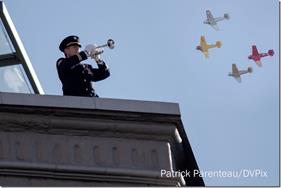


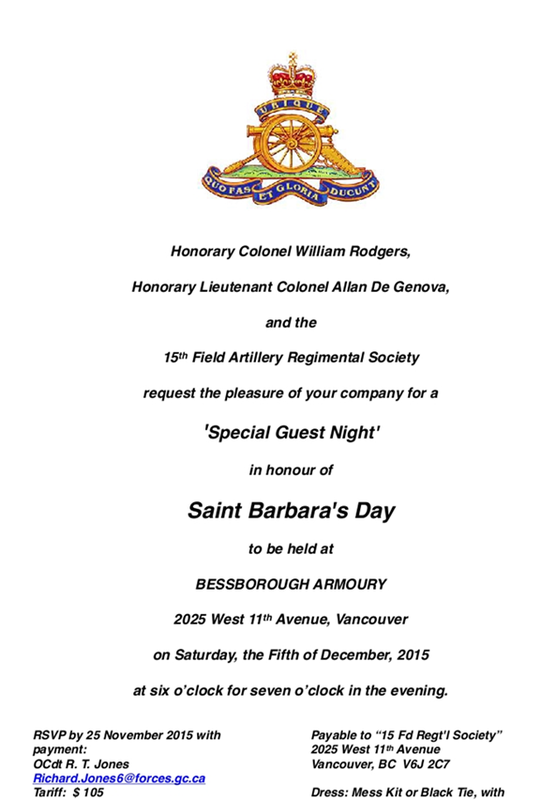
 RSS Feed
RSS Feed